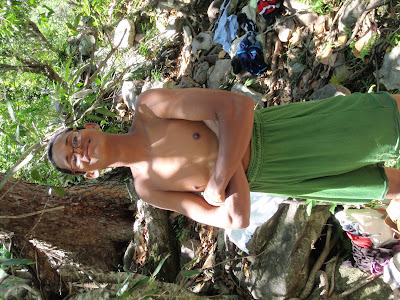72% of women use traditional fogones (three rock stoves) to cook on. Thus why I would like to do a stove project that would provide these beautiful cement cook stoves that still use wood, but much less because the fire attains a hire temperature more quickly and maintains that temperature for a longer period of time. Also, there's a chimney that diverts the smoke out of the kitchen that ought to reduce the respiratory illnesses that are common here.

This is what the traditional stoves look like
90% of families raise some sort of animals. Chickens being the primary animal raised, but pigs, goats, sheep, cows, horses, mules, and burros all ranked in their as well. Also turkeys and guinea hens.


58% of families now have running water from the aqueduct that comes to their houses. This means that now it is a possibility to have a little vegetable garden in the houses for the doñas to grow the vegetables that they use every day like peppers, cilantro, onions, tomatoes, etc. I've already started some compost piles with a couple of the doñas in their houses and we'll be writing a grant soon to get chicken wire to surround our gardens to keep out the chickens and other pests. And we're waiting to get seeds from the Secretary of Agriculture which has a program that provides seeds to groups that hope to diversify the crops they're planting and improve family nutrition.




82% of families have something planted whether in their yards, their fields, or in the mountains. The main crops were corn, beans, and yucca. The majority of these are either fed by rain or by irrigation ditches that run throughout the community. However, in times of dryness, like this time of year, the rains are few and far between in the south where I live due to our location on the west of the mountains and due to the almost complete deforestation in the area which means the rivers and creeks dry up in the summer as well and many crops die due to lack of water. Thus, there's an interest in a reforestation project that in addition to planting much needed trees in the area would also provide an income that would be outside of the traditional agricultural crops that are grown and perhaps bring a higher price in markets both nationally and internationally. Particularly crops such as mangos, avocados, and various other fruit trees.


The river in May

The river in August
47% of the population is below the age of 18, with 72% of that number being under age 12. The reason for this being that many teenagers and young adults have to leave the community have to leave work to study or find work to help support their families because there are few jobs available for youth in the community unless they are helping with the family agriculture which fails to provide much income for the family. Also among those over 18, 37% never went to school and 42% went only to 4th grade or less. Of those between 13 and 17 only 7% never went to school, 12% made it to 4th grade or less and 58% made it to 5th through 8th grade. The information about schooling is still disturbing to me, but at least there is progress being made and a slow recognition of the importance of agriculture. Although, when families need help with harvests and such, the kids still manage to miss quite a bit of school. And in my campo, if it's going to rain they let the kids out early so the teachers can make it back to San Juan. None of the teachers live in the community. There's five schools. Four of them only go until 4th grade and one goes to 8th grade. There's no high school. The kids that want to and can afford to go to high school can either go to San Juan or to Las Zanjas both of which cost 70$ pesos each way and the students are responsible for buying books and uniforms. Thus many youth are excluded because they can't afford the costs of going. The school director has asked that I teach English classes to the 7th and 8th graders which I've agreed to do. In addition, I hope to do an environmental education course in the school. Also, some of my friends want an English class so I may do that for them as well.



























